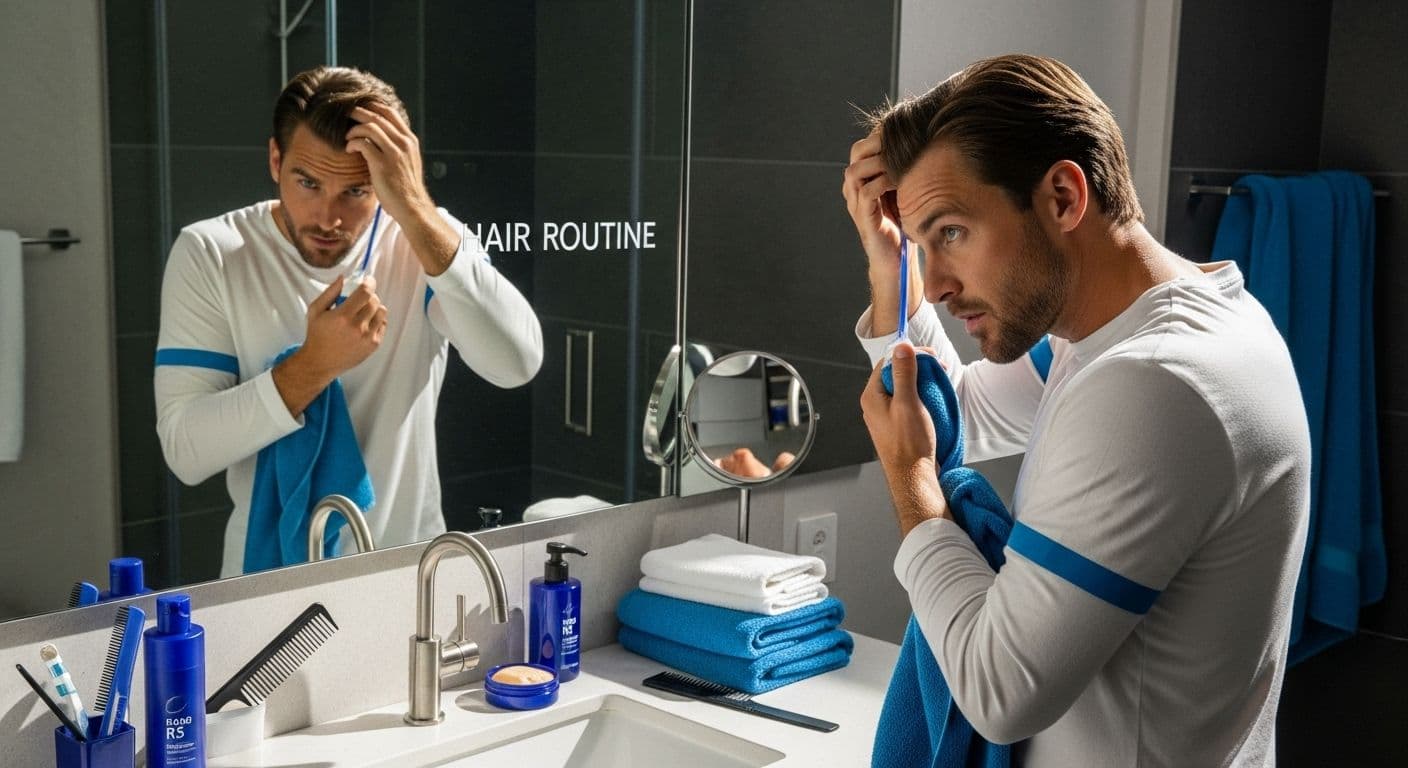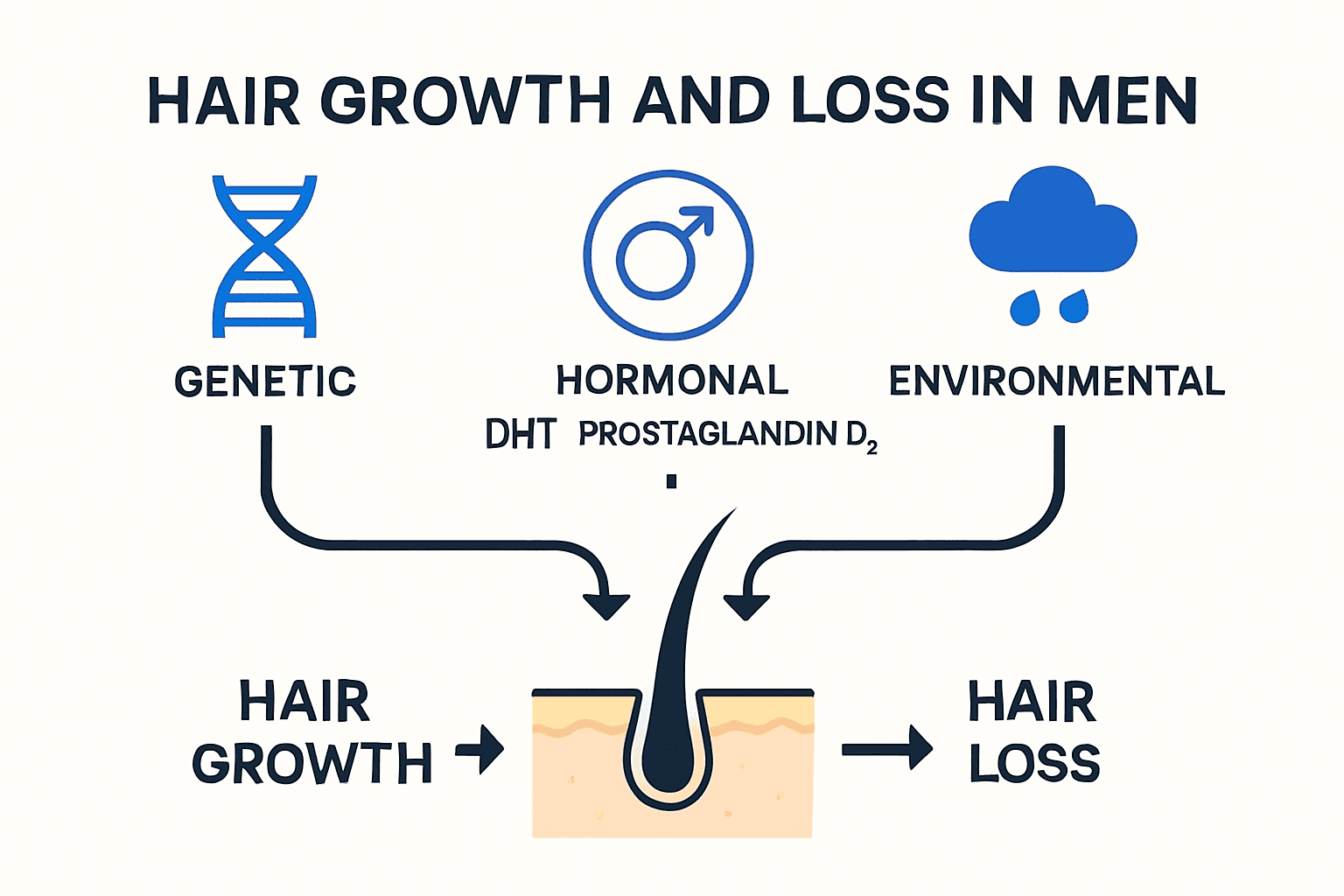Blog
Learning Materials
Essential Hair Routine for Men: Personalize for Growth
Updated: August 10, 2025

Hair loss gets a lot of attention, and for good reason. Up to 50 percent of men between ages 30 and 50 face androgenetic alopecia, also called male pattern baldness. Most think their genetics have ruled their future, and once hair starts thinning, nothing can bring it back. The real surprise is how far science and tech have come, because personalizing your hair care routine can actually change your hair growth story more than you might expect.
Table of Contents
- Understanding Hair Loss And Growth In Men
- Building Your Personalized Hair Routine
- Key Products And Tools For Better Results
- Tips For Tracking Progress And Maintaining Healthy Hair
Quick Summary
| Takeaway | Explanation |
|---|---|
| Understand your hair type. | Assess your hair and scalp characteristics to create a tailored care plan. |
| Incorporate effective treatments. | Use proven products like minoxidil and finasteride to support hair growth. |
| Track your progress regularly. | Document hair density and condition to visualize changes and adapt routines. |
| Seek professional guidance. | Consult healthcare providers for personalized advice and treatment adjustments. |
| Maintain overall health. | Focus on nutrition, stress management, and sleep to support hair growth. |
Understanding Hair Loss and Growth in Men
Hair loss is a complex biological process that affects millions of men worldwide. While often perceived as a purely cosmetic concern, hair loss represents a nuanced interplay of genetic, hormonal, and environmental factors that can significantly impact a person's psychological well-being and self-perception.
The Science Behind Male Hair Loss
Androgenetic alopecia, commonly known as male pattern baldness, represents the most prevalent form of hair loss in men. Research from the National Institutes of Health reveals that up to 50% of men between ages 30 and 50 experience this condition. The primary driver is dihydrotestosterone (DHT), a hormone derived from testosterone that progressively miniaturizes hair follicles.
Genetic predisposition plays a crucial role in determining an individual's susceptibility to hair loss. Men inherit hair loss patterns from both maternal and paternal lineages, making genetic testing an emerging tool for predicting potential baldness trajectories. Interestingly, Johns Hopkins Medicine highlights that contrary to popular myths, factors like poor circulation or simple vitamin deficiencies are not primary causes of significant hair loss.
Emerging Research and Biological Mechanisms
Recent scientific investigations have uncovered fascinating insights into hair loss mechanisms. A groundbreaking study from the University of Pennsylvania identified elevated levels of prostaglandin D2 (PGD2) in bald scalps, suggesting this compound might be a critical inhibitor of hair growth. This discovery opens potential pathways for targeted therapeutic interventions.
Hormonal changes also significantly influence hair growth cycles. Testosterone and its derivative DHT interact with hair follicle receptors, gradually shortening the growth phase and extending the resting phase. This process leads to progressively thinner, shorter hair until follicles eventually become dormant.

Understanding these intricate biological processes is crucial for developing personalized hair care strategies. By recognizing individual genetic predispositions and hormonal profiles, men can explore targeted hair restoration approaches tailored to their specific physiological characteristics.
While hair loss can feel overwhelming, modern science offers increasingly sophisticated solutions. From advanced genetic testing to innovative treatment protocols, men now have more options than ever to address and manage hair loss effectively. The key lies in early recognition, professional consultation, and a proactive approach to understanding one's unique hair health landscape.
Building Your Personalized Hair Routine
Creating a personalized hair routine is not a one-size-fits-all approach. Each man's hair is unique, requiring a tailored strategy that addresses individual hair type, texture, scalp condition, and specific growth challenges.
Understanding Your Hair and Scalp Profile
The American Academy of Dermatology recommends starting with a comprehensive assessment of your hair and scalp characteristics. This involves identifying your hair type (straight, wavy, curly), scalp condition (oily, dry, balanced), and potential concerns like thinning, breakage, or sensitivity.
Key factors to consider in your assessment include:
- Hair Texture: Determines product selection and styling approaches
- Scalp Health: Influences overall hair growth and condition
- Genetic Predispositions: Impacts potential hair loss patterns
Developing a Strategic Hair Care Approach
The Centers for Disease Control and Prevention emphasizes the importance of maintaining scalp hygiene as a foundation for healthy hair growth. A strategic routine should incorporate multiple elements:
- Cleansing: Use sulfate-free shampoos that match your scalp type
- Conditioning: Apply lightweight, targeted conditioners
- Nutrition: Support hair health through diet and potential supplements
Learn more about advanced hair routine strategies that can optimize your hair growth potential.
Professional Guidance and Continuous Adaptation
The Mayo Clinic advises men to be gentle with their hair and adopt a proactive approach. This means:
- Reducing frequent washing to 2-3 times weekly
- Using soft brushing techniques
- Avoiding tight hairstyles that cause scalp stress
- Monitoring hair changes and adjusting routine accordingly
A personalized hair routine is an evolving process. Regular assessment, professional consultation, and willingness to adapt your approach are crucial. By understanding your unique hair characteristics and implementing a targeted care strategy, you can effectively support hair health and potentially mitigate hair loss progression.
Key Products and Tools for Better Results
Successful hair growth management requires a strategic approach to product selection and utilization. Modern hair care technology offers men multiple options to address hair loss and promote healthy hair growth.
Pharmaceutical and Topical Treatments
The Mayo Clinic highlights minoxidil as a primary topical treatment for hair loss. This medication stimulates hair growth by prolonging the hair growth phase, with consistent application potentially reversing miniaturization of hair follicles. Typically applied directly to the scalp, minoxidil works by improving blood circulation and potentially reactivating dormant hair follicles.
Research from the National Institutes of Health also recommends finasteride, an oral prescription medication that inhibits dihydrotestosterone (DHT). By blocking this hormone responsible for hair follicle shrinkage, finasteride can effectively slow hair loss and potentially stimulate new growth. However, users should be aware of potential side effects and consult healthcare professionals before starting treatment.
Advanced Technology and Non-Invasive Solutions
Low-level laser therapy (LLLT) represents a cutting-edge approach to hair restoration. Scientific research demonstrates that light energy can stimulate hair follicles, potentially increasing hair density and promoting growth. These devices range from handheld laser combs to professional-grade helmets, offering men flexible options for integrating this technology into their hair care routine.
Other innovative tools include:
- Scalp Massagers: Enhance blood circulation
- Derma Rollers: Stimulate collagen production
- Specialized Hair Growth Serums: Targeted nutrient delivery
To help you better distinguish between the main types of hair loss treatments and tools discussed, here's a comparison table outlining their key features and considerations.
| Treatment/Tool | Main Function | Method | Key Considerations |
|---|---|---|---|
| Minoxidil (Topical) | Stimulate hair growth | Topical application | Prolongs growth phase; consistency needed |
| Finasteride (Oral) | Block DHT hormone | Oral medication | Prescription required; possible side effects |
| Low-Level Laser Therapy (LLLT) | Stimulate hair follicles | Light device (at home or clinic) | Convenient, non-invasive; requires ongoing use |
| Scalp Massagers | Enhance blood circulation | Manual/electronic use | Improves scalp health; supportive tool |
| Derma Rollers | Stimulate collagen production | Manual micro-needling | Potential irritation if overused |
| Hair Growth Serums | Targeted nutrient delivery | Topical application | Choose serums for your needs and sensitivities |
Holistic Product Selection Strategy
Choosing the right products requires a comprehensive understanding of individual hair characteristics. Explore our comprehensive guide to personalized hair care solutions to develop a nuanced approach tailored to your specific needs.
Key considerations when selecting hair growth products include:
- Personal hair loss pattern
- Scalp sensitivity
- Potential allergic reactions
- Compatibility with existing medications
- Long-term treatment goals
Successful hair care is not about using the most expensive products but selecting scientifically supported solutions that align with your unique physiological profile. Regular monitoring, patience, and professional consultation remain critical in achieving optimal results. By combining advanced technologies, targeted treatments, and a personalized approach, men can effectively address hair loss and promote healthier, more resilient hair growth.
Tips for Tracking Progress and Maintaining Healthy Hair
Tracking hair health and progress requires a systematic and patient approach. Understanding how to monitor changes, document growth, and maintain optimal hair conditions can significantly impact your hair restoration journey.
Documentation and Measurement Techniques
The American Academy of Dermatology recommends establishing a comprehensive tracking system for hair growth. This involves creating a detailed baseline assessment that includes:
- Precise scalp photography
- Detailed hair density measurements
- Systematic documentation of hair thickness
- Regular photographic documentation from consistent angles
Photographic evidence provides objective insights into your hair's transformation, allowing you to visualize subtle changes that might be imperceptible day-to-day. Digital tools and specialized apps can help streamline this documentation process, offering advanced tracking capabilities.
Holistic Health and Hair Maintenance Strategies
Healthline emphasizes the interconnection between overall health and hair quality. Effective tracking extends beyond visual measurements and encompasses:
- Nutritional Monitoring: Track dietary intake of proteins, vitamins, and minerals
- Stress Management: Assess correlation between stress levels and hair health
- Sleep Patterns: Evaluate impact of rest on hair growth
- Hormonal Balance: Regular hormone level assessments
Learn more about comprehensive hair health tracking techniques to optimize your approach.
Long-Term Maintenance and Professional Consultation
The National Health Commission suggests implementing a multi-faceted approach to hair maintenance. Key strategies include:
- Regular scalp health assessments
- Quarterly professional consultations
- Adaptive treatment modifications
- Continuous learning about emerging hair care technologies
Consistent tracking allows for real-time adjustments to your hair care routine. By maintaining detailed records, you create a personalized roadmap that enables targeted interventions and proactive management.
Below is a process table outlining the recommended key steps for tracking hair progress and maintaining overall healthy hair, as described in the article.
| Step | Description | Tools/Methods |
|---|---|---|
| Baseline Assessment | Record initial scalp and hair condition | Photography, documentation |
| Regular Measurement | Track density and thickness periodically | Consistent photo angles, measurement apps |
| Nutritional Monitoring | Track protein, vitamin, and mineral intake | Food diaries, diet apps |
| Stress and Sleep Tracking | Monitor their correlation with hair health | Journals, health apps |
| Ongoing Adjustments | Adapt treatments as needed | Consultation, records |
| Professional Consultation | Seek expert advice and evaluation | Dermatologist/clinician |

Remember that hair growth is a gradual process requiring patience, commitment, and a holistic perspective. While technological tools and tracking methods provide valuable insights, they should complement professional medical advice. Combine objective measurements with professional guidance to achieve optimal results in your hair restoration journey.
Frequently Asked Questions
What should I consider when building my personalized hair care routine?
To create a personalized hair care routine, assess your hair type, scalp condition, and any specific hair concerns like thinning or breakage. Understanding these factors will help you choose the right products and treatments.
How do minoxidil and finasteride differ in treating hair loss?
Minoxidil is a topical treatment that stimulates hair growth by prolonging the growth phase of hair follicles, while finasteride is an oral medication that inhibits dihydrotestosterone (DHT), a hormone that contributes to hair loss. Each works differently, so it's essential to choose based on individual needs and consult a healthcare professional.
How often should I wash my hair for optimal growth?
Washing your hair 2-3 times a week is generally recommended to maintain scalp health and prevent over-drying. This frequency allows natural oils to nourish the hair while keeping the scalp clean.
What role does overall health play in hair growth?
Overall health significantly impacts hair growth. Proper nutrition, stress management, and adequate sleep are essential for optimal hair health. A balanced diet rich in proteins, vitamins, and minerals can support healthy hair growth and prevent hair loss.
Ready to Personalize Your Hair Growth Journey?
Are you frustrated by thinning hair and tired of routines that do not deliver real results? This article shows that a truly effective hair care journey for men starts with personalized insights, targeted routines, and measurable progress. If you want to take charge of your hair health and finally see what works for your unique profile, it is time to go beyond guesswork and outdated advice.

Unlock the power of AI-driven hair analysis at MyHair.ai. Get a custom assessment based on your own scans, track your growth patterns over time, and receive tailored product recommendations – all in one easy-to-use platform. Your hair is unique, and your solution should be too. Discover how you can personalize your hair routine with science-backed insights today. To get started and see real progress, visit MyHair.ai for your personalized hair health plan or learn how AI analysis can transform your results by reading our guide to long hair care routine for strong, fuller hair. Now is the moment to act for your hair.